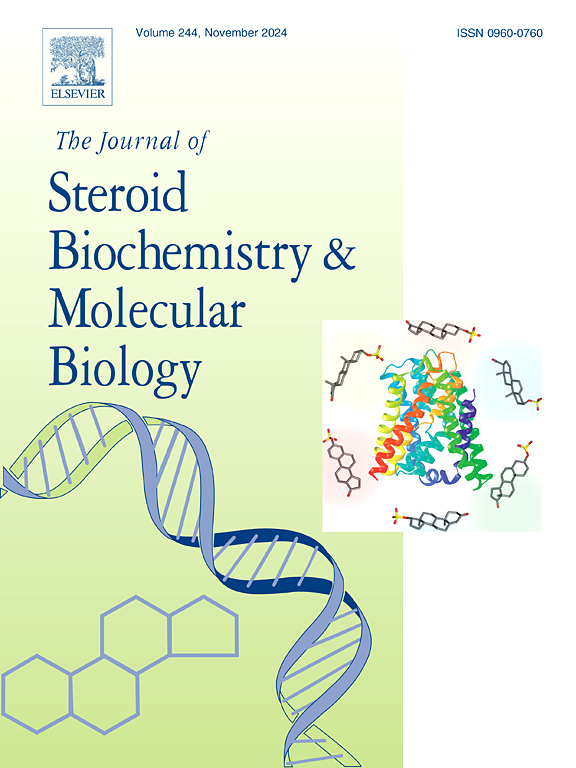Vitamin D promotes wound healing in aged skin by modulating inflammation, angiogenesis, and EMT via the Hippo pathway
IF 2.5
2区 生物学
Q3 BIOCHEMISTRY & MOLECULAR BIOLOGY
Journal of Steroid Biochemistry and Molecular Biology
Pub Date : 2025-06-02
DOI:10.1016/j.jsbmb.2025.106799
引用次数: 0
Abstract
Age-related impairment in skin wound healing represents a significant healthcare challenge. Vitamin D (VD) has been shown to enhance diabetic wound healing. However, its therapeutic potential in age-related wound healing deficits remains unexplored. Here, we investigated VD’s impact on wound healing in aged mice and the underlying mechanisms. Twelve-month-old C57BL/6 J mice received VD supplementation for 3 months before full-thickness excisional wounds were created. Wound healing was evaluated through multiple aspects, including inflammation, angiogenesis, epithelial-mesenchymal transition (EMT), and the Hippo signaling pathway. We also examined responses to 1α,25(OH)2D3 in HaCaT cells. VD supplementation significantly accelerated wound closure by modulating several key processes. It promoted inflammation resolution by suppressing pro-inflammatory factors (IL-6, TNF-α), elevating IL-10 levels, and facilitating M1-to-M2 macrophage polarization. VD enhanced angiogenesis through increased CD31-positive vessel formation and upregulation of angiogenic factors (VEGF, VEGFR2, PDGF). It also promoted EMT, as evidenced by reduced epithelial markers, increased mesenchymal markers, and upregulated EMT-related transcription factors. Mechanistically, VD inactivated the Hippo pathway, shown by downregulated Mst1 and Lats1 expressions, decreased p-YAP protein levels, increased YAP and TAZ protein levels, and upregulated target gene expressions (Cyr61). In vitro studies using HaCaT cells confirmed that 1α,25(OH)2D3 promoted cell migration and EMT through Hippo pathway modulation, as these effects were abolished after verteporfin (YAP inhibitor) treatment. Our findings demonstrated that VD supplementation effectively accelerated wound healing in aged skin by modulating inflammation, increasing angiogenesis, and promoting EMT via the Hippo pathway, suggesting VD as a promising therapeutic strategy for managing age-related wound healing deficits.
维生素D通过Hippo通路调节炎症、血管生成和EMT,促进衰老皮肤伤口愈合
与年龄相关的皮肤伤口愈合损伤是一个重大的医疗保健挑战。维生素D (VD)已被证明可以促进糖尿病伤口愈合。然而,它在与年龄相关的伤口愈合缺陷的治疗潜力仍未被探索。在这里,我们研究了VD对老年小鼠伤口愈合的影响及其潜在机制。12月龄C57BL/6 J小鼠在全层切除创面前补充VD 3个月。通过炎症、血管生成、上皮-间质转化(EMT)和Hippo信号通路等多个方面评估伤口愈合。我们还检测了HaCaT细胞对1α,25(OH)2D3的反应。VD补充通过调节几个关键过程显着加速伤口愈合。它通过抑制促炎因子(IL-6、TNF-α)、提高IL-10水平、促进M1-to-M2巨噬细胞极化来促进炎症消退。VD通过增加cd31阳性血管形成和上调血管生成因子(VEGF, VEGFR2, PDGF)来促进血管生成。它还促进EMT,如上皮标记物减少,间充质标记物增加,EMT相关转录因子上调。在机制上,VD使Hippo通路失活,表现为Mst1和Lats1表达下调,p-YAP蛋白水平降低,YAP和TAZ蛋白水平升高,靶基因表达上调(Cyr61)。HaCaT细胞的体外研究证实,1α,25(OH)2D3通过Hippo通路调节促进细胞迁移和EMT,因为这些作用在维替波芬(YAP抑制剂)治疗后被消除。我们的研究结果表明,VD补充剂通过调节炎症、增加血管生成和通过Hippo途径促进EMT,有效地加速了衰老皮肤的伤口愈合,这表明VD是一种有前途的治疗策略,可以治疗与年龄相关的伤口愈合缺陷。
本文章由计算机程序翻译,如有差异,请以英文原文为准。
求助全文
约1分钟内获得全文
求助全文
来源期刊
CiteScore
8.60
自引率
2.40%
发文量
113
审稿时长
46 days
期刊介绍:
The Journal of Steroid Biochemistry and Molecular Biology is devoted to new experimental and theoretical developments in areas related to steroids including vitamin D, lipids and their metabolomics. The Journal publishes a variety of contributions, including original articles, general and focused reviews, and rapid communications (brief articles of particular interest and clear novelty). Selected cutting-edge topics will be addressed in Special Issues managed by Guest Editors. Special Issues will contain both commissioned reviews and original research papers to provide comprehensive coverage of specific topics, and all submissions will undergo rigorous peer-review prior to publication.

 求助内容:
求助内容: 应助结果提醒方式:
应助结果提醒方式:


